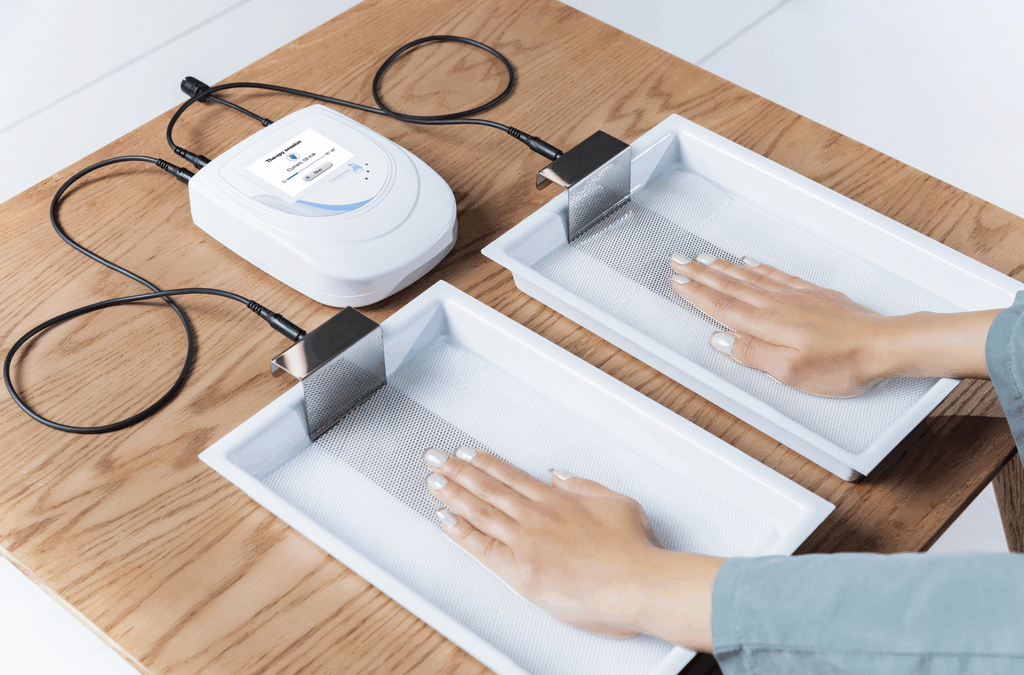Iontophoresis is a non-invasive technique that utilizes electrical currents to enhance the transdermal delivery of charged substances, such as medications, through the skin. This method capitalizes on the skin’s electrical properties to facilitate the penetration of therapeutic agents, offering an alternative to oral or injectable routes.
Mechanisms of Iontophoresis
The effectiveness of iontophoresis is primarily attributed to two mechanisms. The first is electro-migration, which involves the movement of ions across the skin under the influence of an electric field. When a charged drug is placed beneath an electrode of the same charge, the electric current propels the drug ions into the skin. For instance, negatively charged drugs are repelled under the cathode, while positively charged drugs migrate under the anode.
The second mechanism is electro-osmosis, or electro-osmotic flow, which entails the bulk movement of solvent (usually water) induced by the applied electric field. The skin’s natural negative charge causes a net flow of water from the anode to the cathode, aiding in the transport of both charged and neutral molecules across the skin barrier.
Factors Influencing Iontophoretic Transport
Several factors affect the efficiency and effectiveness of iontophoretic drug delivery. For example, the amount of electric current applied per unit area influences drug penetration. Excessive current density can lead to skin irritation or damage.
Next, the configuration of electrodes on the skin plays a key role in the procedure’s efficacy.The size, shape, and placement of electrodes can impact the uniformity of current distribution and, consequently, the consistency of drug delivery.
The charge, size, and solubility of the drug molecules determine their suitability for iontophoresis and their ability to permeate the skin under electrical influence. Finally factors such as skin hydration, thickness, and integrity can affect the permeability of the skin to both the drug and the applied current.
Applications of Iontophoresis
Iontophoresis has found applications in various medical fields. Physical therapists often integrate iontophoresis into their practice as a therapeutic modality to administer medications transdermally, utilizing a mild electrical current to deliver drugs directly through the skin to targeted tissues. This technique is particularly effective in treating conditions such as tendinitis, bursitis, and scar tissue management, where localized anti-inflammatory or analgesic medication delivery can significantly reduce pain and inflammation. By employing iontophoresis, therapists can provide non-invasive, targeted treatment options that enhance patient outcomes and expedite recovery processes.
Dermatologists may employ iontophoresis as a non-invasive technique to enhance the delivery of therapeutic agents for various skin conditions. By applying a mild electrical current, iontophoresis facilitates the transdermal administration of medications, improving treatment efficacy for issues such as acne, hyperpigmentation, and signs of aging. This method allows for targeted therapy, minimizing systemic side effects and offering an effective alternative to traditional topical applications.
Finally, iontophoresis has powerful pain management applications. By applying a mild electrical current, this technique facilitates the movement of charged analgesic drugs through the skin, directly targeting underlying tissues and providing localized pain relief.
This approach is particularly beneficial for patients with acute or chronic pain, as it allows for rapid onset of therapeutic effects while minimizing systemic side effects associated with oral or injectable medications. For instance, studies have demonstrated that iontophoresis can effectively deliver morphine systemically in concentrations sufficient to provide postoperative pain relief in patients undergoing total knee or hip arthroplasty.
Additionally, advancements in iontophoretic technology have enhanced the feasibility of transdermal application for acute and episodic pain management, further establishing its role in contemporary analgesic therapies.
Advantages of Iontophoresis
Iontophoresis offers several advantages, including non-invasive drug delivery that eliminates the need for needles, thereby providing a painless alternative for administration. This method allows for targeted treatment by directing medications to specific areas, enhancing therapeutic efficacy while minimizing systemic exposure. Additionally, localized delivery often leads to reduced side effects compared to systemic administration.
However, despite these benefits, iontophoresis has limitations such as potential skin irritation, including redness, itching, or burns, especially with prolonged or improper use. Not all individuals are suitable candidates for this treatment; factors such as skin condition, the nature of the drug, and the presence of implanted medical devices must be carefully considered to ensure safety and effectiveness.
Additionally, not everyone is a suitable candidate for iontophoresis. Factors like existing skin conditions, the type of medication being used, and the presence of implanted medical devices need careful consideration to ensure the treatment’s safety and effectiveness.
Effective iontophoresis requires specialized devices and trained healthcare professionals to ensure safety and efficacy. The devices used typically consist of a power supply, electrodes, and a controller, all designed to deliver a controlled electrical current for therapeutic purposes. While some portable iontophoresis devices are available, many require a direct power source, such as a plug, to operate effectively.
Further, proper administration necessitates a thorough understanding of the technique by healthcare providers, including patient selection criteria, appropriate electrode placement, current intensity settings, and knowledge of the specific medications being delivered. This expertise helps minimize potential side effects and maximizes therapeutic benefits. Additionally, healthcare professionals play a crucial role in educating patients on the correct use of iontophoresis devices, especially when used at home, ensuring that patients can safely and effectively manage their treatment regimens. Overall, iontophoresis represents a sophisticated approach to delivering medications through the skin, offering targeted treatment options that continue to evolve with ongoing research.

